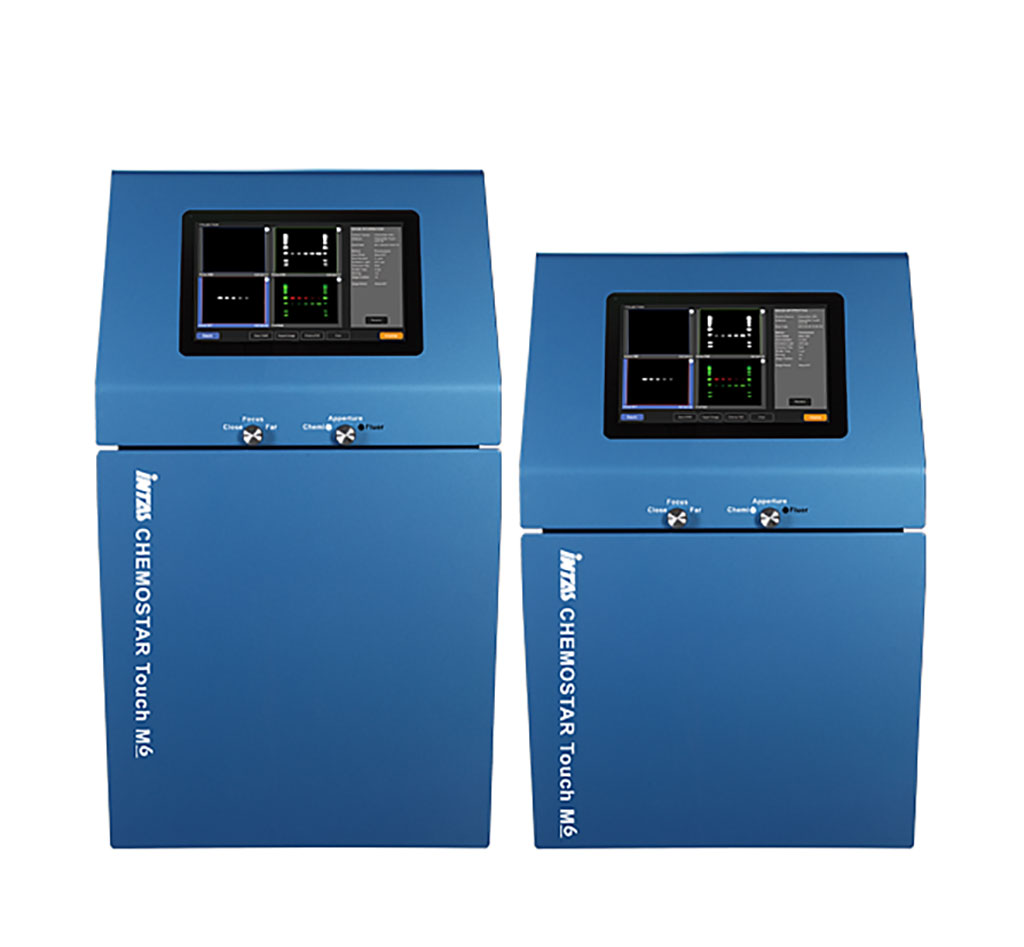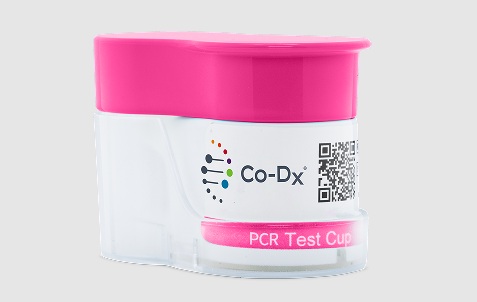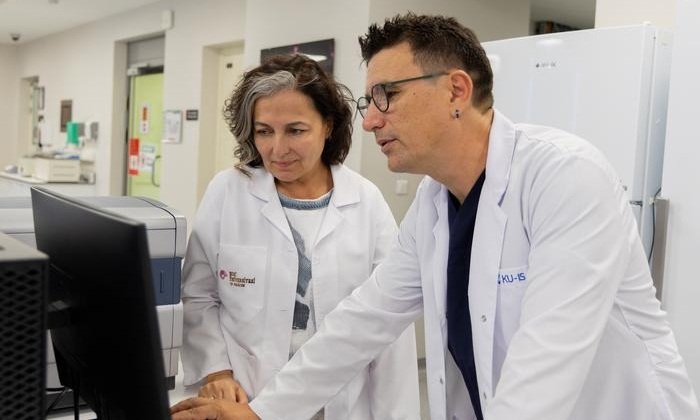Non‐Invasive Urine Markers Differentiate Renal Cancer from Oncocytoma
|
By LabMedica International staff writers Posted on 25 May 2021 |

Image: The CHEMOSTAR Touch ECL & Fluorescence Imager (Photo courtesy of INTAS)
Clear cell renal cell carcinoma, (ccRCC), is a type of kidney cancer. Clear cell renal cell carcinoma is also called conventional renal cell carcinoma. Clear cell renal cell carcinoma is named after how the tumor looks under the microscope.
Renal oncocytoma is a benign (noncancerous) growth of the kidney. They generally do not cause any signs or symptoms and are often discovered incidentally while a person is undergoing diagnostic imaging for other conditions. Some people with renal oncocytoma will have abdominal or flank pain; blood in the urine; and/or an abdominal mass.
Urologists at the University Hospital Cologne (Cologne, Germany) have shown that that Vim3 is overexpressed in tissue samples of renal oncocytomas and Mxi‐2 in clear cell renal carcinoma (ccRCC). They collected urine samples from patients suspected of kidney cancer between 2015 and 2018. The final cohort consisted of 350 patients, with pathohistological proof of an oncocytoma in 20 patients or a RCC (50 chromophobe; 40 papillary); 200 clear cell RCC (ccRCC), as well as 40 negative controls.
The medical scientists performed Western blots on urine samples which were analyzed with INTAS Chemostar (Göttingen, Germany). ELISAs were performed using incubated 3B4 Vimentin antibody and for Mxi‐2 and analyzed on the FLUOstar Omega plate reader (BMG LABTECH, Ortenberg, Germany). The team also carried out lateral flow assays; and quantitative real‐time polymerase chain reaction (qRT‐PCR).
The investigators reported that there was a significant increase of Vim3 in urines from patients with oncocytoma and was detectable with ELISA compared to all other subtypes of RCCs. Mxi‐2 was predominantly overexpressed in ccRCCs. Lateral flow assay of Vim3 and Mxi‐2 shows two bands in the case of oncocytoma and ccRCC indicating the specificity of this test. For small renal masses (SRMs), an overexpression of miR‐15a/Mxi2 was detectable in urine samples from ccRCC and chromoRCC patients. In contrast to that, miR‐498/Vim3 were predominantly overexpressed in oncocytoma patients.
The authors concluded that using the highly specific, non‐invasive urine markers, Vim3 and Mxi‐2, they were able to fill the gap and reduce the number of overtreated patients as well as the number of unnecessary surgeries. Furthermore, even the detection as well as pre‐surgical differentiation in small kidney cancers is possible with the measurement of the two predicted miRs as well as the proteins. Both proteins (Vim3 and Mxi‐2) were detectable in patients’ urines and can be used for the non‐invasive differentiation of kidney cancers. The study was published on May 7, 2021 in the Journal of Clinical Laboratory Analysis.
Related Links:
University Hospital Cologne
INTAS
BMG LABTECH
Renal oncocytoma is a benign (noncancerous) growth of the kidney. They generally do not cause any signs or symptoms and are often discovered incidentally while a person is undergoing diagnostic imaging for other conditions. Some people with renal oncocytoma will have abdominal or flank pain; blood in the urine; and/or an abdominal mass.
Urologists at the University Hospital Cologne (Cologne, Germany) have shown that that Vim3 is overexpressed in tissue samples of renal oncocytomas and Mxi‐2 in clear cell renal carcinoma (ccRCC). They collected urine samples from patients suspected of kidney cancer between 2015 and 2018. The final cohort consisted of 350 patients, with pathohistological proof of an oncocytoma in 20 patients or a RCC (50 chromophobe; 40 papillary); 200 clear cell RCC (ccRCC), as well as 40 negative controls.
The medical scientists performed Western blots on urine samples which were analyzed with INTAS Chemostar (Göttingen, Germany). ELISAs were performed using incubated 3B4 Vimentin antibody and for Mxi‐2 and analyzed on the FLUOstar Omega plate reader (BMG LABTECH, Ortenberg, Germany). The team also carried out lateral flow assays; and quantitative real‐time polymerase chain reaction (qRT‐PCR).
The investigators reported that there was a significant increase of Vim3 in urines from patients with oncocytoma and was detectable with ELISA compared to all other subtypes of RCCs. Mxi‐2 was predominantly overexpressed in ccRCCs. Lateral flow assay of Vim3 and Mxi‐2 shows two bands in the case of oncocytoma and ccRCC indicating the specificity of this test. For small renal masses (SRMs), an overexpression of miR‐15a/Mxi2 was detectable in urine samples from ccRCC and chromoRCC patients. In contrast to that, miR‐498/Vim3 were predominantly overexpressed in oncocytoma patients.
The authors concluded that using the highly specific, non‐invasive urine markers, Vim3 and Mxi‐2, they were able to fill the gap and reduce the number of overtreated patients as well as the number of unnecessary surgeries. Furthermore, even the detection as well as pre‐surgical differentiation in small kidney cancers is possible with the measurement of the two predicted miRs as well as the proteins. Both proteins (Vim3 and Mxi‐2) were detectable in patients’ urines and can be used for the non‐invasive differentiation of kidney cancers. The study was published on May 7, 2021 in the Journal of Clinical Laboratory Analysis.
Related Links:
University Hospital Cologne
INTAS
BMG LABTECH
Latest Clinical Chem. News
- Compact Raman Imaging System Detects Subtle Tumor Signals
- Noninvasive Blood-Glucose Monitoring to Replace Finger Pricks for Diabetics
- POC Breath Diagnostic System to Detect Pneumonia-Causing Pathogens
- Online Tool Detects Drug Exposure Directly from Patient Samples
- Chemical Imaging Probe Could Track and Treat Prostate Cancer
- Mismatch Between Two Common Kidney Function Tests Indicates Serious Health Problems
- VOCs Show Promise for Early Multi-Cancer Detection
- Portable Raman Spectroscopy Offers Cost-Effective Kidney Disease Diagnosis at POC
- Gold Nanoparticles to Improve Accuracy of Ovarian Cancer Diagnosis
- Simultaneous Cell Isolation Technology Improves Cancer Diagnostic Accuracy
- Simple Non-Invasive Hair-Based Test Could Speed ALS Diagnosis
- Paper Strip Saliva Test Detects Elevated Uric Acid Levels Without Blood Draws
- Prostate Cancer Markers Based on Chemical Make-Up of Calcifications to Speed Up Detection
- Breath Test Could Help Detect Blood Cancers
- ML-Powered Gas Sensors to Detect Pathogens and AMR at POC
- Saliva-Based Cancer Detection Technology Eliminates Need for Complex Sample Preparation
Channels
Molecular Diagnostics
view channel
Sample Prep Instrument to Empower Decentralized PCR Testing for Tuberculosis
Tuberculosis remains the deadliest infectious disease worldwide despite being both treatable and curable when diagnosed early. A major barrier to timely diagnosis is that PCR-based TB testing is still... Read more
Endometriosis Blood Test Could Replace Invasive Laparoscopic Diagnosis
Endometriosis affects an estimated 1 in 10 women globally, yet diagnosis can take 7 to 10 years on average due to the invasive nature of laparoscopy and lack of accurate, non-invasive tests.... Read more
World's First NGS-Based Diagnostic Platform Fully Automates Sample-To-Result Process Within Single Device
Rapid point-of-need diagnostics are of critical need, especially in the areas of infectious disease and cancer testing and monitoring. Now, a direct-from-specimen platform that performs genomic analysis... Read more
Rapid Diagnostic Breakthrough Simultaneously Detects Resistance and Virulence in Klebsiella Pneumoniae
Antibiotic resistance is a steadily escalating threat to global healthcare, making common infections harder to treat and increasing the risk of severe complications. One of the most concerning pathogens... Read moreHematology
view channel
MRD Tests Could Predict Survival in Leukemia Patients
Acute myeloid leukemia is an aggressive blood cancer that disrupts normal blood cell production and often relapses even after intensive treatment. Clinicians currently lack early, reliable markers to predict... Read more
Platelet Activity Blood Test in Middle Age Could Identify Early Alzheimer’s Risk
Early detection of Alzheimer’s disease remains one of the biggest unmet needs in neurology, particularly because the biological changes underlying the disorder begin decades before memory symptoms appear.... Read more
Microvesicles Measurement Could Detect Vascular Injury in Sickle Cell Disease Patients
Assessing disease severity in sickle cell disease (SCD) remains challenging, especially when trying to predict hemolysis, vascular injury, and risk of complications such as vaso-occlusive crises.... Read more
ADLM’s New Coagulation Testing Guidance to Improve Care for Patients on Blood Thinners
Direct oral anticoagulants (DOACs) are one of the most common types of blood thinners. Patients take them to prevent a host of complications that could arise from blood clotting, including stroke, deep... Read moreImmunology
view channel
Ultrasensitive Liquid Biopsy Demonstrates Efficacy in Predicting Immunotherapy Response
Immunotherapy has transformed cancer treatment, but only a small proportion of patients experience lasting benefit, with response rates often remaining between 10% and 20%. Clinicians currently lack reliable... Read more
Blood Test Could Identify Colon Cancer Patients to Benefit from NSAIDs
Colon cancer remains a major cause of cancer-related illness, with many patients facing relapse even after surgery and chemotherapy. Up to 40% of people with stage III disease experience recurrence, highlighting... Read moreMicrobiology
view channel
New UTI Diagnosis Method Delivers Antibiotic Resistance Results 24 Hours Earlier
Urinary tract infections affect around 152 million people every year, making them one of the most common bacterial infections worldwide. In routine medical practice, diagnosis often relies on rapid urine... Read more
Breakthroughs in Microbial Analysis to Enhance Disease Prediction
Microorganisms shape human health, ecosystems, and the planet’s climate, yet identifying them and understanding how they are related remains a major scientific challenge. Even with modern DNA sequencing,... Read morePathology
view channel
AI Tool Simultaneously Identifies Genetic Mutations and Disease Type
Interpreting genetic test results remains a major challenge in modern medicine, particularly for rare and complex diseases. While existing tools can indicate whether a genetic mutation is harmful, they... Read more
Rapid Low-Cost Tests Can Prevent Child Deaths from Contaminated Medicinal Syrups
Medicinal syrups contaminated with toxic chemicals have caused the deaths of hundreds of children worldwide, exposing a critical gap in how these products are tested before reaching patients.... Read more
Tumor Signals in Saliva and Blood Enable Non-Invasive Monitoring of Head and Neck Cancer
Head and neck cancers are among the most aggressive malignancies worldwide, with nearly 900,000 new cases diagnosed each year. Monitoring these cancers for recurrence or relapse typically relies on tissue... Read moreTechnology
view channel
AI Predicts Colorectal Cancer Survival Using Clinical and Molecular Features
Colorectal cancer is one of the most common and deadly cancers worldwide, and accurately predicting patient survival remains a major clinical challenge. Traditional prognostic tools often rely on either... Read more
Diagnostic Chip Monitors Chemotherapy Effectiveness for Brain Cancer
Glioblastoma is one of the most aggressive and fatal brain cancers, with most patients surviving less than two years after diagnosis. Treatment is particularly challenging because the tumor infiltrates... Read moreIndustry
view channel
BD and Penn Institute Collaborate to Advance Immunotherapy through Flow Cytometry
BD (Becton, Dickinson and Company, Franklin Lakes, NJ, USA) has entered into a strategic collaboration with the Institute for Immunology and Immune Health (I3H, Philadelphia, PA, USA) at the University... Read more


















